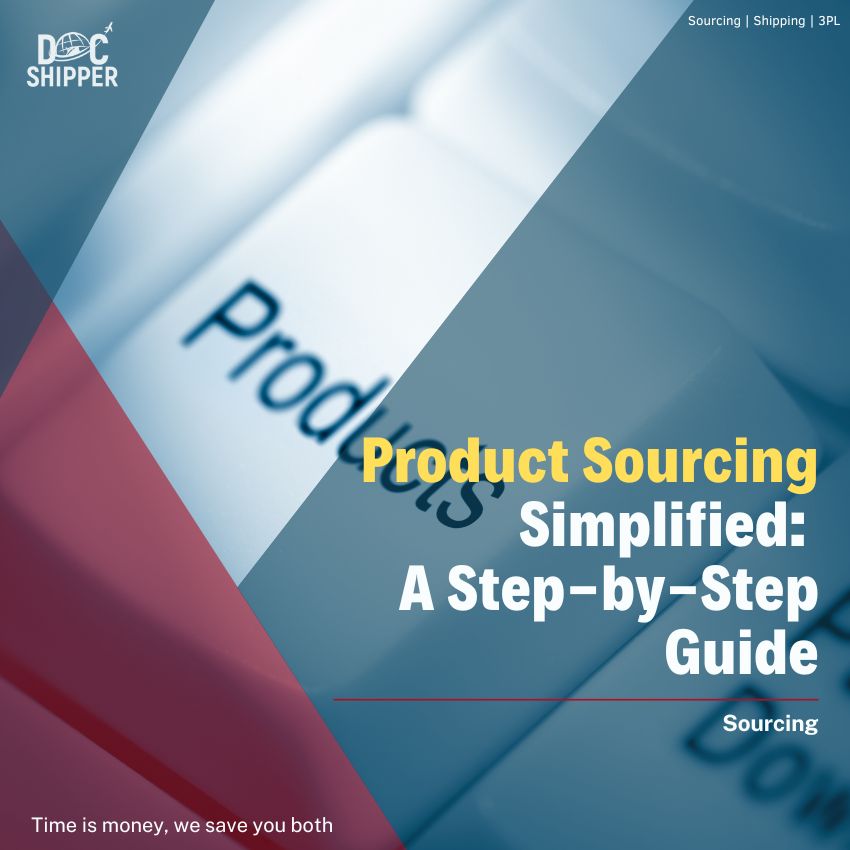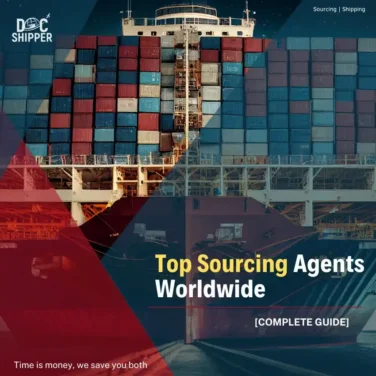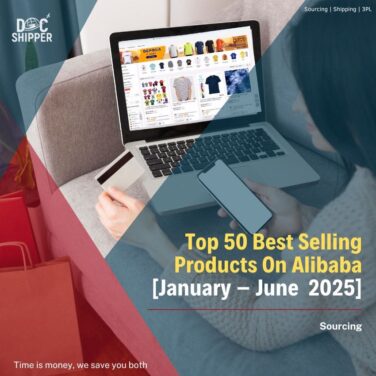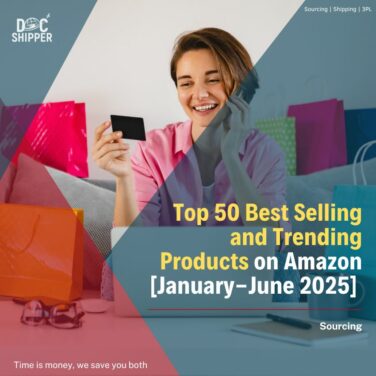Nowadays, most companies’ visions revolve around the customer journey and experience. To keep consumers satisfied, businesses need to fulfill their needs, in terms of product availability and quality. That’s why, product sourcing is a vital process for all enterprises. Whether you are running a brick-and-mortar or an online business, you need to establish a sourcing strategy, that will organize and improve your activities. However, searching for relevant suppliers, both locally and worldwide, can be time-consuming and daunting. For this particular reason, you can seek assistance from a sourcing expert like Docshipper, who, thanks to their wide experience in the field, will help you save time and money.
To delve deeper into the subject, we have carefully created a beginner’s guide for you, which provides you with answers to all your questions.
What is product sourcing?

Product sourcing can be defined as the process by which a business discovers and procures wares from reliable suppliers. Furthermore, it encompasses researching, approaching, and negotiating with suppliers to obtain high-quality products at reasonable prices for resale in various retail settings, whether offline or online.
DocShipper Info
DocShipper info : In general, the words sourcing and procuring are used as synonyms, which is not the case in logistics. Procuring products involves obtaining materials while sourcing products entails finding and vetting suppliers before purchasing. In this article, we explain more about Sourcing vs. Procurement: what’s the difference? Contact us for more information!
Sourcing products: from where should I start?
Finding a pertinent supplier who offers products that meet your needs, and establishing a long-term relationship with them, is the ultimate goal for all companies. Therefore, while searching for new suppliers, it is essential to explore various channels to find suitable options for direct and indirect sourcing.
Consider online sources
In today’s digital era, most people start by searching online to get instant and rapid answers. Consequently, we suggest different perspectives.
You can explore the supplier’s website for more information about their specific offerings and services, or browse online supply platforms, like RangeMe.
You can also take a look at product sourcing apps, like Faire: Sell Wholesale App. On such platforms, you will find different offers from different suppliers, allowing you to compare and choose the most relevant one for your needs.
Explore trade shows
Although participation in trade shows has experienced a downward trend in recent times, they persist as a pertinent and indispensable avenue for buyers to engage in new product exploration and procurement. These events afford buyers immediate information, the opportunity for direct product inspection, and face-to-face negotiation with suppliers.
DocShipper Tip
Docshipper Tip :Finding a supplier on your own, can be very tricky, as you will encounter myriad options such as manufacturers, wholesalers, artisans, and other creators. However, DocShipper can help clear up any confusion. Thanks to our sourcing service, we can assist you throughout the whole process. Contact us for more insight and customized guidance.
How to source products in 07 steps?
The sourcing strategy is a lengthy and critical process, as it involves more than merely identifying excellent merchandise and incorporating it into a store.
Nevertheless, there are 7 steps that buyers should follow to facilitate their activities and save time.
1. Elaborate a Market Research

Market research is an efficient tool that companies use to gather information about customers’ preferences and concerns, competitors’ offerings, and environmental trends.
Conducting valid studies allows enterprises to develop and implement effective strategies that enhance business growth. Generally, there are two types of studies: primary market research and secondary market research.
- Primary market research: It is a study in which companies consider customers as the main source of information. They are questioned in focus groups, one-to-one interviews, questionnaires (…) using open-ended questions in an exploratory research context, or “straight to the point” questions in a specific research context.
- As a result, the obtained data could be quantitative (measurable, numbers…) or qualitative (descriptive, interpretation-based);
- Secondary market research: To assemble secondary data, companies use public sources such as previous market research, articles, magazines, websites, etc. Nowadays, thanks to the Internet, this type of information is very accessible; all you need is to look for trustworthy websites.
Some companies, however, decide to engage a consulting firm to conduct market research as they’re more experienced in the field. Additionally, their decision can be based on other features such as business objectives, the agency’s previous projects, the pricing that the company is willing to invest, etc.
Yet, if you are considering market studies internally (i.e. when the company engages its employees to conduct them), here are some mistakes that you should avoid:
- Poor sampling: Carefully choose people who will answer your questions. Sticking to your target audience is essential; otherwise, your results and interpretations will be flawed;
- Unclear objectives: You cannot conduct market research merely for the sake of conducting market research. Having a clear and precise vision is crucial for the validation of the results;
- Relying merely on one type of study: Focusing only on secondary research or primary research will not be beneficial. The obtained data could be restricted and may not provide the necessary information, resulting in irrelevant analysis and outcomes;
- Poor communication: In primary research, your customers are your principal source of information. To obtain the maximum amount of data from them, engage in thorough conversation and ask clarifying questions when needed.
2. Establishing a budget
Following comprehensive product research and market analysis, this step involves a comparison of competitor pricing and formulation of a financial plan before engaging with suppliers.
Thus, it is necessary to avoid these common mistakes:
- Ignoring competitor pricing: Always compare and analyse competitor pricing to set realistic budget targets;
- Overlooking hidden costs: Ensure that potential expenses such as shipping, import duties (…) are taken into consideration to avoid budget shortfalls;
- Neglecting environmental changes: Maintain a long-term vision while creating your budget. Do not disregard market future changes and conditions. Include an additional amount of money in your budget as a risk margin;
- Not revising the budget regularly: Your budget needs to be revised and adjusted occasionally, to adapt to changes and ensure effective financial management.
3. Identifying suitable suppliers

Currently, as a retailer, you have myriad options for suppliers worldwide. However, you need to be careful when choosing because you may encounter products that do not fully meet your required specifications and features. As a consequence, this step focuses on aligning product requirements with your suppliers’ capabilities. You can achieve this through online research or by leveraging existing connections from expos and trade shows.
Accordingly, to select a genuine supplier who can contribute effectively to your success, avoid these frequent mistakes:
- Rushing the selection process: Take your time during the search process, and carefully evaluate a supplier’s potential. Additionally, consider online reviews on different channels to verify a supplier’s reputation, track record, and reliability. Otherwise, you may encounter issues such as late deliveries or poor product quality;
- Neglecting the payment terms: While it’s common to focus on the cost of the merchandise, mistreating payment terms can lead to unexpected additional expenses. Consequently, it’s vital to evaluate other factors such as payment terms, and shipping costs (…) to ensure that the overall value proposition aligns with your business goals;
- Overlooking location and logistics: Consider the supplier’s location to ensure compatibility with your distribution network. This consideration will help you minimize shipping costs, lead times, and logistical challenges.
DocShipper Tip
Docshipper Tip: If you are having a hard time choosing a sourcing strategy that meets your requirements, you can seek help from specialists like Docshipper. Thanks to their extensive experience worldwide, they can help you choose the strategy that meets your needs. Get in touch with us f you have any questions.
4. Sampling products
Once you find relevant suppliers, don’t assume that your deal is closed. Even if reviews are positive, and the supplier has a good reputation, it’s prudent to demand a sample for more assurance. During this step, it is recommended to closely examine the product with your procurement team and choose the one with the most reliable quality.
Furthermore, we suggest abstaining from these common errors:
- Sampling from only one supplier: Request samples from multiple suppliers to expand your options and ultimately make a better selection. Compare different product qualities and choose the one that best meets your requirements;
- Falling to document findings: It’s essential to document the sampling process and interpretations, to maintain records for reference. This will prevent any confusion and disputes later on.
By avoiding these mistakes, you can ensure a more accurate and effective product sampling process, leading to better decision-making when selecting suppliers.
5. Implementing supplier trials
Supposedly, the quality of the sample meets your standards, your work is not yet complete. Even if the product itself is good, suppliers’ other services may not be suitable. Thus, it is necessary to opt for a trial period for furthermore assurance. Take a strategic approach to assess product viability and supplier reliability before committing to a long-term partnership.
However, be cautious during the trial period and avoid these pitfalls:
- Rushing the trial process: Don’t conduct supplier trials just for the sake of it. Have a clear plan and evaluate the process thoroughly to avoid inaccurate assessments and poor decision-making;
- Ignoring Key Performance Indicators (KPIs): When planning the trial periods, do not forget to establish clear KPIs that enable you to evaluate supplier performance. Ignoring them can result in subjective judgments and unreliable outcomes.
6. Conducting thorough supplier evaluations during the sampling and trial phases
This step involves systematically assessing and analysing potential suppliers’ performance, reliability, and suitability based on predetermined criteria. You need to establish clear metrics and graphs that allow you to compare results and obtain valid information. As a result, you’ll determine whether working with this supplier was beneficial or not.
Furthermore, you should be careful since these mistakes usually occur during this step:

- Incomplete evaluation criteria: Failing to establish comprehensive evaluation criteria may result in overlooking important factors that could affect supplier performance and suitability;
- Subjective assessments: Allowing personal biases or preferences to influence evaluations can lead to inconsistent and unreliable results;
- Ignoring feedback: Disregarding feedback from stakeholders involved in the evaluation process, such as procurement teams or end-users, can lead to overlooking critical perspectives and requirements.
7. Maintaining a repository of backup suppliers
During the final step, it is advisable to develop a contingency plan to mitigate potential disruptions. This plan ensures the uninterrupted supply of goods in the face of unforeseen events, such as business mergers or discontinuations.
Furthermore, here are some mistakes that you should avoid
- Over-reliance on a single backup supplier: Relying too heavily on one backup supplier may leave the organization vulnerable if that supplier experiences issues or disruptions;
- Neglecting to assess backup supplier capabilities: Not thoroughly evaluating the capabilities and capacities of backup suppliers can result in selecting inadequate alternatives during emergencies;
- Lack of communication: Failing to communicate effectively with backup suppliers about expectations, requirements, and emergency protocols can lead to confusion and delays during implementation.
DocShipper Alert
DocShipper Alert: Be cautious of the potential misconceptions that can occur while sourcing worldwide, as they could potentially affect your activity. These include importing the wrong products, placing a large order before researching the supplier, expecting the supplier to be knowledgeable about overseas sales channels, etc. To learn more about common mistakes in sourcing, explore our article. For additional information, contact us.
Succeeding your product sourcing: best practices & tips
Strategic sourcing steps can appear complicated, which is why we provide you with these tips to succeed in your business:
Prioritize local sourcing

Local sourcing encompasses the acquisition of goods from domestic suppliers rather than international entities.
Opting for local procurement has the potential to result in reductions in supply chain expenditures, expedited product launches, and augmented revenue streams.
Additionally, engaging with local suppliers enables first-hand inspection of products and facilitates face-to-face meetings, thereby fostering the establishment of closer relationships.
Stay updated on industry trends
Staying updated on industry trends is critical for successful product sourcing. This involves monitoring industry developments, technological advancements, and market trends. By staying informed, businesses can adapt their sourcing strategies to capitalize on emerging opportunities, anticipate market changes, and stay competitive. This includes tracking industry publications, attending events, engaging with experts, and leveraging technology to streamline processes. Ultimately, staying abreast of industry trends enables businesses to make informed decisions and maintain relevance in the dynamic marketplace.
Experiment with different sourcing strategies
There are various sourcing strategies, and each has its specifications and benefits. It involves various methods to manage supplier relationships and mitigate procurement risks.
- Single sourcing: Relying solely on one supplier, fostering a close relationship but increasing dependence;
- Multiple sourcing: Engaging with several suppliers to diversify sources and promote competition;
- Dual sourcing: Splitting volume between suppliers to ensure supply continuity;
- Delegated sourcing: Consolidating responsibility with one supplier, potentially reducing costs but altering power dynamics;
- Parallel sourcing: Working with individual suppliers across different product groups for flexibility;
- Network sourcing: Allocating volume among multiple suppliers, fostering cooperation and competition;
- Triadic sourcing: Selecting two similar suppliers, balancing relationships, and fostering competition within a triad structure.
We encourage exploring each one to determine which one works best for you. Among the most used strategies is multiple sourcing, as it helps mitigate the risks associated with sourcing by opting fr different suppliers.
Why should you multiply the sources of your products?

Some people may wonder about the importance of having multiple suppliers; they might presume that it is better to be loyal to only one supplier and maintain a long-term relationship with them. However, the business landscape is constantly evolving, marked by uncertainty and rapid changes, especially in the post-COVID period. The global pandemic has underscored the need for adaptability and resilience in supply chain management. Additionally, the advent of artificial intelligence and technological evolution further emphasizes the importance of diversification.
Hence, in this section, we will outline the benefits of multiple sourcing strategies.
Benefit 1: Mitigation of stockouts
Stock-outs present insufficient inventory to fulfill demand, caused by inadequate inventory management or unforeseen spikes in demand. The availability of multiple suppliers serves as a solution for this problem, ensuring resilience in emergencies and providing alternative resources.
Benefit 2: Optimization of Pricing
Maintaining relationships with multiple suppliers enhances bargaining power. They’re also facilitating the negotiation of more favourable terms. Suppliers are ready to be competitive when they are aware of other options available to the buyer.
Benefit 3: Assessment of Product Quality
Sourcing goods from diverse suppliers helps identify differences in product quality across different sources. This enables a thorough examination of any decline in quality and an understanding of its underlying causes. Consequently, if the lower-quality problem persists, the buyer can explore other alternative suppliers to uphold quality standards.
DocShipper Tip
Docshipper Tip : Before contacting a supplier, have a look at customers’ reviews on different platforms, to be sure about their service quality and reputation. However, if you want to save time, you can contact DocShipper. Our sourcing services are well-known worldwide. With our supplier database, we can provide you with relevant suppliers. For more information, get in touch with us
When should I source for a New Supplier?

The consideration of new suppliers becomes crucial when business requirements evolve, and the offerings of current suppliers fail to meet them. Here are some signs indicating that it is time to seek out a new supplier.
When your business grows
As your business grows, the competency of your suppliers is something you should take into consideration. If your business requirements change, such as the need for faster delivery of orders, increased order volumes, or a wider product range, you may have to reconsider your supplier relationships. The evaluation of compliance with suppliers becomes key in such situations.
Consider the size of orders your supplier can provide
Switching from small independent suppliers to manufacturers, or wholesalers when customer demand increases might be beneficial. This will allow you to obtain larger quantities since their capacity is significantly higher.
You desire to manufacture or customize new products
If you have built strong brand loyalty in your business, or found hidden potential in offering unique products, a strategy to move away from standard offerings to customized or private-labelled items should be developed.
Hence, if you need more personalized and customized products, you should consider sourcing from a new supplier who will allow you to customize your goods as much as you like.
DocShipper Tip
Docshipper Tip : To overcome communication barriers, consider engaging an import agent or a Trade company in China. With their experience in the region, they can help you navigate and avoid these issues. For the last 11 years, we, at Docshipper, have been assisting businesses to source products in China and worldwide. Contact us to learn more about our sourcing service and competitive advantages.
What’s the best way to source products from China?

Retailers, whether they are sourcing products to sell online or in their physical shops, are always wondering about how to find where companies source their products. Generally, they opt for sourcing from low-cost countries to maximize profit, such as sourcing from Asia.
Currently, sourcing from China is a decision commonly appreciated and considered by myriad businesses. Statistics indicate that, in 2023, China’s exports amounted to approximately .3.38 trillion U.S. dollars. This achievement allowed the country to become the largest exporter in the world.
If you are starting to source from China, here are some tips that you need to consider:
Find the right supplier
Use search engines or online platforms like Alibaba to create a shortlist, but prioritize direct manufacturers for specialized products to reduce costs and ensure quality.
Consider cost and quality
Recognize that low manufacturing costs in China may impact product quality, so avoid suppliers offering significantly lower prices and be wary of negotiations that compromise quality or worker conditions.
Communicate clearly
In global sourcing, communication is often considered one of the barriers. Therefore, businesses should be cautious of misunderstandings that could potentially be deal-breakers. However, despite the widespread use of English in Asia, language and culture gaps still pose challenges while sourcing products from China. As a consequence, we encourage you to bridge language and culture gaps by documenting all requirements, specifications, and expectations in writing to prevent misunderstandings and delays.
Conduct quality control inspections
Implement regular inspections throughout the production process to maintain product quality and prevent costly mistakes.
Conclusion: Whether operating online or in physical spaces, establishing a solid product sourcing strategy is essential. Businesses can effectively overcome sourcing hurdles by partnering with trustworthy suppliers and implementing industry best practices. Collaborating with experienced partners like Docshipper can simplify the sourcing process and optimize outcomes, ensuring competitiveness in the global market.
DocShipper Procurement Specialist’s Advice on Product Sourcing

Molka Baghdadi
Sourcing and procurement expert at DocShipper Group
LinkedIn Profile : https://www.linkedin.com/in/baghdadi-molka-20a06b187/
Q1: What challenges do you commonly encounter as a sourcing expert when sourcing products internationally, especially from China?
Molka: Ah, the challenges – they keep us on our toes, don’t they? One thing we often encounter is keeping the quality vibe consistent across our international suppliers. And then, there’s the cultural gap. Different styles of communication and negotiation can trip us up. So, we make it a point to have crystal-clear specs and wide-open channels to avoid any missteps.
Q2: How do you stay updated on market trends and developments in China to make informed sourcing decisions?
Molka: I would say that staying in the loop is the basis of the sourcing game! We’re constantly on the lookout, whether it’s hitting up trade fairs or diving deep into market trends, new tech, and all the rule changes in China. It’s like being on a never-ending treasure hunt, keeping our sourcing strategies as fresh as a morning breeze.
Q3: How do you strike a balance between cost, quality, and sustainability in your sourcing strategies?
Molka: At Docshipper we, our sourcing team, and I, perceive this as a great challenge to keep us aiming for solutions that surpass our competitors. I keep looking for suppliers who align with our client’s values – top-notch quality, sustainability…
Negotiating fair prices is a must, but at DocShipper we also want our supply chain to be in harmony with ethical and sustainable practices. It’s a delicate exercise, but we’ve got the rhythm down.
Q4: Can you share an innovative sourcing strategy you’ve implemented recently or observed in the industry?
Molka: Lately, I have been on this collaboration spree. I usually think that successful sourcing is about a strong partnership with our suppliers. We’re investing together in research and development, creating this ecosystem of innovation. It’s like planting seeds for a garden of cutting-edge products. The best part? It’s a dance that leads to long-term relationships and growth for everyone.
Q5: For procurement professionals sourcing products internationally, what advice would you give them to navigate cultural differences during negotiations?
Molka: Ah, the cultural gap! My advice would be to take it slow, like any induction program. Learn the moves of the region you’re dealing with. Speak their language, not just the words, but the vibes. And you know what adds to the magic? Establishing a personal connection. Trust me, it’s like the secret sauce in these international negotiations.
Q6: In your experience, how has technology impacted the product sourcing landscape, especially when dealing with international suppliers?
Molka: Oh, technology, is literally our innovation and perfection engine at DocShipper! AI, automation, real-time communication, tracking shipments with a few clicks – have changed the game.
Platforms connecting you and suppliers globally? They’re like your backstage pass to a sourcing world that’s transparent and accessible. It’s tech bringing the rhythm to the sourcing beat.
Q7: Can you share a bit about your role as a sourcing and procurement expert at DocShipper and your experience in product sourcing in China?
Molka: Of course! So, I wear the hat of a sourcing specialist here at DocShipper. My world revolves around finding reliable suppliers in China and making sure they’re the perfect match for what our clients need. I’ve been at this game for a good while, juggling a variety of products and mastering the ropes of international trade.
Q8: What would be your last piece of advice to someone who wants to start product sourcing in China?
Molka: Absolutely, my final piece of advice for anyone diving into product sourcing in China would be two-fold. First, educate yourself thoroughly about the market, regulations, and cultural nuances. Knowledge is your best ally in navigating the complexities.
Second, build strong relationships. Whether it’s with suppliers, industry experts, or even fellow sourcing professionals, networking and fostering connections can open doors to valuable insights and collaborations. Remember, in the world of international sourcing, knowledge and relationships are your most powerful tools. Best of luck!
FAQ | Product Sourcing Simplified: A Step-by-Step Guide
Read more
Looking for more? These articles might interest you:
DocShipper info: Do you like our article today? For your business interest, you may like the following useful articles :
Need Help with Logistics or Sourcing ?
First, we secure the right products from the right suppliers at the right price by managing the sourcing process from start to finish. Then, we simplify your shipping experience - from pickup to final delivery - ensuring any product, anywhere, is delivered at highly competitive prices.


Fill the Form
Prefer email? Send us your inquiry, and we’ll get back to you as soon as possible.
Contact us








